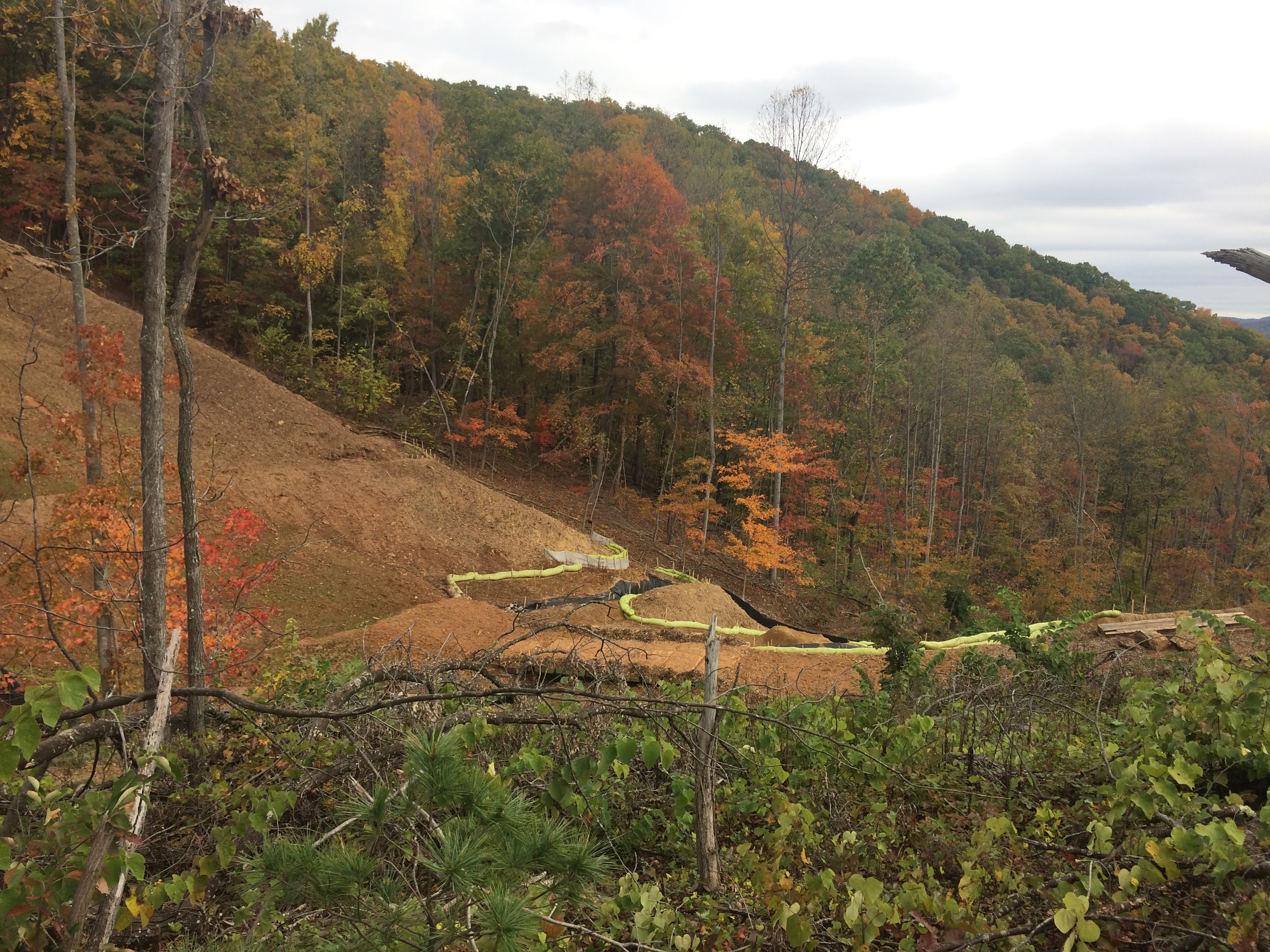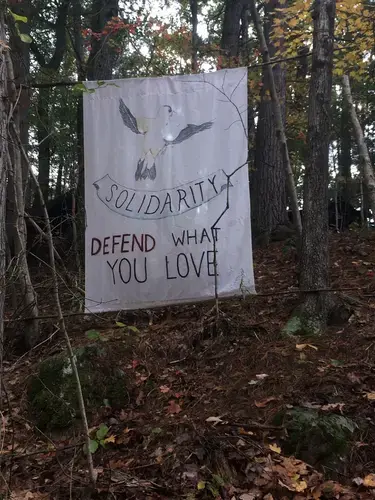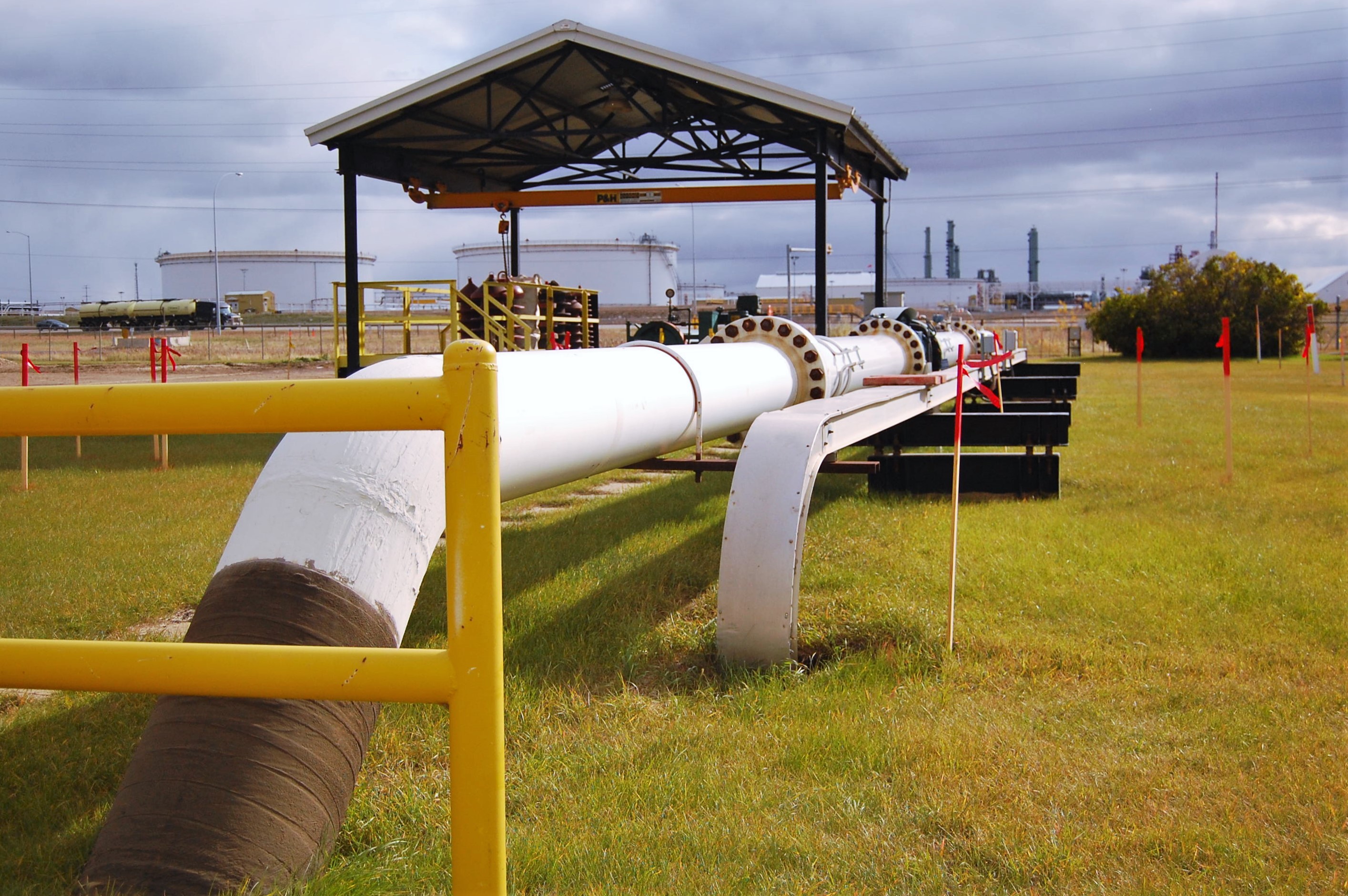
Drive past small houses and cows on Yellow Finch Road, and blue yard signs line the gravel road. “Stream Crossing” is written in big letters, and the logo of the Mountain Valley Pipeline corporation is tucked in the corner. The signs acknowledge the over 1,000 locations where the Mountain Valley Pipeline crosses water bodies.
As the road narrows, handmade fabric banners are hung in trees with messages like “Water Is Life,” a motto of the Standing Rock protests against the Dakota Access Pipeline, and “Solidarity: Defend What You Love” with a drawing of a yellow finch. At around this point in the road, a clear difference appears in the left and right sides of the road.
The right side has been clear cut, with netting and fertilizer capsules on top to grow grass, while the left side looks like a healthy forest. On the left, a makeshift staircase has been built into the steep land, leading up to a campsite built among the trees. People of all ages are sitting on benches around a small fire with a tarp hung above them. The camp on its own is remarkable as a communal home in the woods, but the camp isn’t the point.
A dozen steps from the camp is an oak tree, and 50 feet up in the oak tree is a person living on a small platform. A few steps further is a white pine with another person living in it. They have been in the trees for more than 500 days as of January, “tree-sitting” to stop the Mountain Valley Pipeline. They have received national media attention and they are far from alone in their actions.
In the past six months, a man in Tasmania, Australia was arrested for tree-sitting to prevent the logging of old growth forests, a woman was arrested in Columbia, Missouri, for tree-sitting to prevent the removal of old trees for a new bike trail, and a tree-sitter left a centuries old tree on Rainbow Ridge in Northern California after she successfully prevented a logging company from cutting the tree down.
Around the world, pipelines are being protested, including the Coastal GasLink pipeline in the Wet’suwet’en Nation in British Columbia, the Northeast Supply Enhancement Pipeline in North Brooklyn, New York, and the Jordan Cove LNG Project in Oregon—all making news in early February. With the Mountain Valley Pipeline specifically, more than 40 people have been charged in relation to direct action like tree-sitting, as reported by the Roanoke Times.
Throughout Virginia and West Virginia along the pipeline route, a coalition of neighbors have come together in a variety of ways to protect the places they call home and have strengthened their communities in the process. With their work, they hope to offer a model for support and base-building in a world increasingly suffering from environmental harm.

The Mountain Valley Pipeline was proposed as a 303-mile-long, 42-inch-wide natural gas pipeline system that would transport natural gas from Wetzel County, West Virginia, to Pittsylvania County, Virginia, about the distance from Philadelphia to Boston. When first proposed, it was set to be in service in 2018, but it has since been pushed to late 2020, and its expected construction costs have increased 77 percent to $5.3 billion.
While the Mountain Valley Pipeline corporation says the construction of the pipeline is 90 percent complete as of early 2020, many landowners argue that it cannot be more than 75 percent complete, that costs will continue to increase, and that it will never go into service because of resistance. As of February 2020, the pipeline was under a stop-work order due to violation of the Endangered Species Act and is missing four permits needed for stream crossings and work in the Jefferson National Forest, according to the Virginia Department of Environmental Quality.
“They make all of these claims, but they haven't pumped a molecule of gas through that thing and they never will,” said Russell Chisolm, an organizer against the pipeline.
Organizers attribute these setbacks to their fight to stop the pipeline, which began with the first whispers of the plan. They hope their community activism will continue long after the pipeline is defeated.
“We want to stop the pipeline. We want to make sure that no Democrat ever runs statewide with a pro-pipeline agenda, and we want to make it so difficult for these pipeline companies to come to Virginia that no pipeline ever dreams about trying to come through Virginia in the future,” Delegate Sam Rasoul, who represents Roanoke in the Virginia House of Delegates, said in an interview.
People oppose the Mountain Valley Pipeline and pipelines in general for a wide variety of reasons. For many, the pipeline is a manifestation of global fights on climate change and energy policy that are playing out in their backyards, and they feel an obligation to take a strong stance. While it feels like they have little power in the international or even national conversation on these issues, some find power in disrupting the construction of the pipeline through direct action, legal processes, research or organizing.
“It feels really powerful for people to be like oh, I can go stop construction for a day. Even if the government cannot or won’t stop construction, I can do that myself,” shared an organizer with Appalachians Against Pipelines who requested anonymity because of the group’s direct action activities.
A 2017 study by Oil Change International found the Mountain Valley Pipeline would produce annual greenhouse gas emissions equivalent to adding 26 more coal plants or 19 million more passenger vehicles to the state.
There are environmental objections to the pipeline construction as well. The first step in construction is clearing land which often leads to erosion and sedimentation that damages bodies of water and ecosystems.
The risk of leaks or explosions also weighs heavily on landowners and locals. According to FracTracker Alliance, a research organization that studies the risks of oil and gas, from 2010 to 2017, pipelines led to almost 100 fatalities, 500 injuries and over 17.55 billion cubic feet of natural gas leaked.
Others oppose the pipelines because of their opposition to government overreach. Landowners have had their land seized through eminent domain, and critics ask whether the prerequisites of need and public benefit are met. They also believe that the land is being taken by private corporations who are using it to make a profit that landowners will never see.
In March 2015, Steve Bernard arrived at his home of 40 years in Franklin County, Virginia and noticed strangers and trucks on his land. Without Bernard’s permission, the workers were surveying his land for the Mountain Valley Pipeline. In November 2017, Bernard and his wife, Anne, along with 300 other landowners were sued by the Mountain Valley Pipeline corporation so it could acquire rights and easements over their property.
“When people first started to realize what they were up against, the law discombobulated them enough to let the surveyors do what they wanted to do,” said Bernard during an interview at his home.
By July 2018, workers employed by the Mountain Valley Pipeline corporation dug a trench through their land in two days and put the pipeline in the ground.
“The day after it was put in, there was a heavy rain and the pipe was floating in the water, so they just buried it, unattached to anything,” said Anne Way Bernard.
The Bernards are artists who fell in love in college in Richmond in the 1970s. After college, the couple moved to Boones Mill, Virginia, and Steve joined his father’s construction company for job security.
“I’ve retired and I paint full time now. At the time that I want to do the most, my life has been invaded by the pipe,” Steve shared.
“We’ve had this [pipeline] come through here and take our Eden and create this hellish ‘War of the Worlds’ landscape. Walk out the door and you can’t forget about it. Even if it’s covered up, I know it’s there. I can feel it, I can almost hear it,” Anne elaborated.
The Bernards are one example of hundreds of landowners along the route whose lives have been disrupted and damaged by the construction of the Mountain Valley Pipeline.
Jammie Hale also had his land seized under easement for the pipeline. “I built my house in 2010. I’ve based my whole life on this farm and it’s all gone now… It’s hard watching every day, the trucks beeping on your land. It takes a toll on you after a while,” said Hale.
In the wake of the pipeline, grassroots community groups of landowners and other locals formed in counties along the pipeline route with like-minded missions and tactics, focused on preserving the local environment by stopping the pipeline.
In a meeting of one of these groups called Preserve Craig County, the room was full of chatter and laughter among neighbors, most of whom were strangers before the pipeline threatened their collective homes. During introductions, people were making connections, handing each other business cards and discussing their passions and community involvement.
“The good thing about this pipeline is the passion and energy it has galvanized. We have something that will last after we win to help us for years and years, decades and decades,” said Andrew Downs, the director of the Appalachian Trail Conservancy, at the meeting at the Craig-Botetourt Electric Cooperative in early January.
Many of these groups have united in a coalition called Protect Our Water, Heritage, Rights [POWHR]. One way POWHR opposes the pipeline and protects the region is by facilitating and conducting research on the impacts of fossil fuel infrastructure development in Appalachia under the name Mountain Valley Watch.
Mountain Valley Watch is a collaboration of volunteers and experts who observe, document, and report environmental issues related to the construction of the Mountain Valley Pipeline.
“There was a lot of interest in doing this construction monitoring, holding the builders accountable, but also holding regulators accountable for what’s happening out there. We gave it a name basically and we brought in expertise and people that were willing to do the work to have kind of a holding place for all that information as it’s exchanged,” shared Chisholm, vice-coordinator of Preserve Giles County and co-chair of POWHR.
When the pipe began floating in the Bernards’ yard, they recorded it by taking photos and sent them to Mountain Valley Watch. From the start of the construction to December 2019, Mountain Valley Watch has received almost 800 submissions of similar incidents from residents of impacted localities that they report to the Virginia Department of Environmental Quality.
One incident of sediment runoff they reported in September 2019 led to a stay of construction on the pipeline due to violation of the Endangered Species Act. Other reports have included severe sediment-laden runoff into creeks, rivers and roads including Yellow Finch Road in February 2020, recurrent erosion problems, and mudslides.
While Mountain Valley Watch relies on landowners to report incidents to them, they also rely on the landowners for access to their property to launch drones, and this connection has led to close relationships.
Jason Shelton, co-owner of New River Geographics and leader in Mountain Valley Watch, reflected on the network that has been built from Mountain Valley Watch monitoring: “When you go out to someone’s house, you don't just go out to their house and grab your stuff and start hiking. You go out to their house and then you talk for a while and then you go hiking then you come back and talk about what you hiked and did. You’re not just talking to people and helping them, you're making new friends and actually spending time. What [the landowners] want to see is you care as much about the area as they do on their property.”
Dr. Emily Satterwhite is another leader in POWHR. In addition to her work with POWHR, she is a professor at Virginia Tech and involved politically in supporting candidates who oppose the Mountain Valley Pipeline. In June 2018, she chained herself to an excavator on Brush Mountain to block construction. While she held her ground in the excavator for 14 hours, she was joined by friends, students, and fellow activists in solidarity.
“The community bonding around this has been the gift, having or finding other people who also believe it’s so wrong they have to fight. If I were the only person who thought that, I’d probably be miserable,” said Satterwhite.
Tree-sitters and the on-the-ground team at Yellow Finch agree.
Hale explained that “some bring water, some bring food, medicine. All gears are turning at all times. I couldn’t do any of this by myself, I couldn’t do it just me and him, we need all of us to come together.”
A person who identified themself as Stompy shared from the oak tree that “the reality is that we’re sitting ducks and none of this is possible without support. I’ve seen other campaigns of people doing this, but it’s rarely been this supportive. There’s just flows of supplies coming in at all times.”
For them, it’s about more than stopping the pipeline.
“We have to think about how to turn community resources into environmental support outside of capitalist structures as climate chaos takes over," Stompy said. "Things are really critical for humanity in general and we need to try new things.”
Hale echoed the same sentiment on the ground. “It’s brought us all together and we’ve set aside our differences. I’ve met people from all walks of life, but we all have one goal which is stopping the pipeline and creating a cleaner, better world for the future.”
Although the pipeline has destroyed land, damaged lives and its fate is uncertain, there is a consensus among the organizers and those affected that they have gained something from the fight.
“I wasn’t originally from Roanoke; I feel like I am now," said Katherine Wilkin, coordinator of POWHR. "I feel like I live here and this is my home, and I don’t think that was something I would’ve felt if it weren’t for this fight.”

Education Resource
Meet the Journalists: Megan O'Toole and Jillian Kestler-D'Amours
A planned expansion of Canada's Trans Mountain pipeline has divided Indigenous communities in the...















